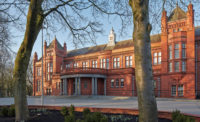Gelsenkirchen, Germany
Gelsenkirchen is one of those German postindustrial cities that is just not on the tourist trail, unless you are a fan of its top-flight soccer club, Schalke. Set in the heart of the Ruhr megalopolis—the coal-mining and steelmaking area in the northwest of the country—the town was heavily bombed during World War II and rebuilt. But one notable prewar building survived and has now been restored, and transformed, at a cost of $97 million. This is Gelsenkirchen's city hall, known as Hans-Sachs-Haus.
The building—named after Hans Sachs, the 16th-century Meistersinger from Nuremberg immortalized in Wagner's opera but, oddly, lacking a local connection—was conceived as a palace for the people. Containing a concert hall, public library, restaurant, civic offices, and a hotel in a stubby 11-story tower to the rear, this design was ambitious at a time of economic crisis. Come World War II, a bomb reduced one corner to rubble and burned much of the interior; postwar, the exterior damage was carefully repaired, the interior redone in austere fashion, and an extension built at the rear in a 1950s-modern style. But over the following decades, neglect speeded the building's deterioration, and it was slated for demolition. Protests from conservationists eventually convinced the authorities to keep the facade of the building and to run an architectural competition for its reuse. Von Gerkan, Marg and Partners (GMP), one of Germany's highest-profile international architectural practices, won in 2008—nicely in time for the global recession and its delays.
Now the renovation is complete. On a recent day, founding partner Volkwin Marg met me there for coffee with project architect Jutta Hartmann-Pohl: the restaurant is back. And although at first glance there is no concert hall, half of the large open floor at the rear of the ground level can be closed off by tall acoustically treated doors to make a 400-person multipurpose hall, expanding to 1,200 seats when opened to the skylit atrium at the center of the building. So music, then, is also back. The majority of the building is taken up with civic offices, including a two-story council chamber directly above the multipurpose hall and the office of the city mayor. A mini-museum, aimed at schoolchildren, wraps round the council chamber on two levels.
“Fischer's architecture here was a complete mixture–modern, traditional, and expressionist,” says Marg. “The building reflected some of the confusion of the time.” Essentially, GMP has dropped a wholly new concrete-frame donut-shaped atrium structure into the old shell, removing the postwar extension and creating a full-height glazed and solar-shaded facade at the rear, facing southwest. Here the original building, essentially U-shaped, had no presence. This facade–intended as a metaphor for the transparency of the political process within—is bookended by new brick corners that copy the existing facade, wrapping around to the back: the bricks are nearly identical to the originals, and you have to look very hard to distinguish new from old.
Inside, Marg and Hartmann-Pohl have paid homage to the lost original interiors, both in the pioneering Bauhaus-influenced color-coding of floors by designer Max Burchartz (1887–1961) and in two staircases, redone in a convincing 1920s manner. Remarkably, most of the original exterior timber window frames could be kept and fitted with new double-glazed units. The aesthetic is predominantly that of today, but with a nod to the past: the glass balustrades are as smoothly radiused around the new atrium corners as the brick is on the exterior, and the deep beams beneath the atrium roof recall those of the original concert hall. Their black cherry timber also harmonizes in tonality with the blue-gray Irish limestone floors in the public areas.
Last, there is the tower, rising five levels above the rest of the building. Its floor plates have been left in their raw state, with future uses to be determined. You can see up to the roof through Fischer's original concrete framing. The feel here is industrial, and that's appropriate: we are in the Ruhr. This building was always a symbol for the city, and on the wet Thursday I visited, the restaurant was packed: the people have returned to their Haus. Generally, I'm wary of “facadism”—the rebuilding of old buildings that are gutted, leaving only their facades—too often an excuse for poorly conceived architecture behind. Not here. GMP has entered into the spirit of the Weimar Republic, designing an architectural conversation across nearly a century. This is enlightened reuse.
Hugh Pearman is architecture critic for The Sunday Times (London) and editor of the Journal of the Royal Institute of British Architects.
PeopleOwner: Client: City of Gelsenkirchen, Central Property Management
Architect:
Personnel in architect's firm who should receive special credit:
Consultant(s): Lighting design: Conceptlicht Other: signage: Formkombinat, Hamburg, Germany Photographer(s): Hans Georg Esch Size: 249,000 square feet Cost: $97 million Completion date: August 2013 |
Products
Exterior cladding
Roofing Other: Roff greening by ZinCo GmbH
Glazing Skylights: RAICO Other: Strähle Glass Paritions
Doors Sliding doors DORMA GmbH + Co. KG Upswinging doors, other: Strähle Raum-Systeme GmbH
Hardware Security devices: CES Other special hardware: Vieler dorr handles
Interior finishes Demountable partitions: Movabl Doors by Nüsing GmbH & Co. KG
Floor and wall tile: Natural limestone: by Zeidler & Wimmel Natursteinindustrie GmbH & Co. KG Special interior finishes unique to this project: Special manufactured furniture for the Council Hall by “spiegels First Class Office”
Furnishings Tables: Fa. Brunner Group
Conveyance |































